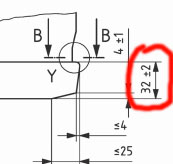When we’ve got questions about the boot/binding interface — or just wonder the “why” of a given boot feature, we find ourselves frequently referring to ISO 9523:2015, the industry “norm” for “ski touring boots.” You might also see 9523 referenced in ski touring binding user manuals.
Thoughts regarding boot dimension standards: Some tech touring bindings provide a stomp pad under the boot heel, specified to have a given clearance, thus requiring your boot heel to have somewhat standard dimensions. And consider ski boot toe wear caused by dirt hiking, and how thicker rubber could fix that, but providing a thicker sole is conflicted by the ISO standard dimensions. This list could go on for pages.

Ski touring boot heel dimensions.
Side view of ISO 9523:2015 ski touring boot heel dimensions shown to right. Heel specific issues with AT backcountry skiing boots are things like the binding heel not closing when you step down, or the boot having vertical play once the binding is closed, or stomp pads not being close enough to the boot sole. If you experience any of that, check your dimensions based on the ISO drawing above. For example, see that the vertical thickness of the sole heel is 32 mm <>2 mm (measure by placing boot on a flat surface and measure up from surface. If your binding is acting funny and your boot is within this spec (many of ours measure at 30 mm) then look at the binding for problems such such as improper adjustments. If the boot is out of spec or at the extreme end of the range, then consider fixes such as grinding to reduce thickness (rarely necessary), or re-soling if your boots are worn from dirt hiking (likely).
ISO 9523 boot toe dimensions have issues as well. One of our pet issues here is that most AT boots could have more rubber at the toe, where most wear happens while walking. As shown in the diagram, this would be easy to accomplish while sacrificing some rocker. Many soles could even be made overall thicker (most of ours measure at around 28 mm), but doing this can be difficult in the case of Dynafit bindings, as the amount of sole below the Dynafit fitting is critical in how the binding operates.
Bottom Line: Many ski touring boots conform to DIN/ISO 9523, some do not. In particular, many of the skimo race oriented boots do not, and boots with the Dynafit Speed Nose do not.
WildSnow.com publisher emeritus and founder Lou (Louis Dawson) has a 50+ years career in climbing, backcountry skiing and ski mountaineering. He was the first person in history to ski down all 54 Colorado 14,000-foot peaks, has authored numerous books about about backcountry skiing, and has skied from the summit of Denali in Alaska, North America’s highest mountain.
